Foreword / YouTube Video Review
I purchased this speaker myself out of pure curiosity.
The review on this website is a brief overview and summary of the objective performance of this speaker. It is not intended to be a deep dive. Moreso, this is information for those who prefer “just the facts” and prefer to have the data without the filler. The video below has more discussion with respect to the technical merits and subjective notes I had during my listening sessions.
For help understanding the data, I encourage you to watch this video which discusses the implications of (some of) the data shown below:
Information and Photos
Some specs from the manufacturer can be found here.
WiFi speaker with 180-degree sound and a lamp base in one makes sound blend into the home. Choose between a white or black speaker and complement with a glass or fabric lamp shade. Then enjoy the sound – a collaboration between IKEA and Sonos! All SYMFONISK speakers connect over WiFi so you can create the system you want in your home. Play a podcast in the bedroom while someone else listens to music in the living room, or group all your speakers to play music in sync. SYMFONISK WiFi speaker allows you to stream music, radio, and podcasts from your network and streaming services. You can group two or more SYMFONISK speakers together so they play the same content in sync and you can control the volume of individual speakers in the group. 180-degree sound means that the sound spreads out better in the room – and provides a better experience for the listener. Use as the only sound source in a room or complete with your existing products from the SYMFONISK series or Sonos products and easily expand your sound system. Supports all of the major music streaming subscription services. Compatible with Airplay 2 so you can stream audio directly from your Apple devices. Compatible with Spotify Connect, which means you can stream music directly to the speaker from your Spotify app. Works with IKEA Home smart. You control the speaker with the Sonos app.
Price is approximately $140.99 USD for the lamp base which comes in black (as shown) or white. Lamp shades come in different options: textile and glass which vary in price from $30 USD to $50 USD. A full lamp setup therefore can cost anywhere from $170 to $190 USD. I am evaluating the speaker using the textile lamp shade, as pictured in the initial photo of this review.
Lamp base without shade.
CTA-2034 (SPINORAMA) and Accompanying Data
All data collected using Klippel’s Near-Field Scanner. The Near-Field-Scanner 3D (NFS) offers a fully automated acoustic measurement of direct sound radiated from the source under test. The radiated sound is determined in any desired distance and angle in the 3D space outside the scanning surface. Directivity, sound power, SPL response and many more key figures are obtained for any kind of loudspeaker and audio system in near field applications (e.g. studio monitors, mobile devices) as well as far field applications (e.g. professional audio systems). Utilizing a minimum of measurement points, a comprehensive data set is generated containing the loudspeaker’s high resolution, free field sound radiation in the near and far field. For a detailed explanation of how the NFS works and the science behind it, please watch the below discussion with designer Christian Bellmann:
The reference plane in this test is at the tweeter axis, as best as I can tell. There are no teardown photos of this speaker so I spent some time running tests to find the best axis for overall response.
You’ll notice there is some data missing that I provide in other reviews. That’s intentional. This speaker is a different animal and I tested it for fun. The data I am providing is more of a “check this out” than a “let’s deep dive into the response curves”. I don’t see the benefit of spending additional time on graphics that will likely just confuse the majority of readers. Nor do I see a benefit in spending additional time performing those tests and creating the graphics to post.
Measurements are provided in a format in accordance with the Standard Method of Measurement for In-Home Loudspeakers (ANSI/CTA-2034-A R-2020). For more information, please see this link.
CTA-2034 / SPINORAMA:
The On-axis Frequency Response (0°) is the universal starting point and in many situations it is a fair representation of the first sound to arrive at a listener’s ears.
The Listening Window is a spatial average of the nine amplitude responses in the ±10º vertical and ±30º horizontal angular range. This encompasses those listeners who sit within a typical home theater audience, as well as those who disregard the normal rules when listening alone.
The Early Reflections curve is an estimate of all single-bounce, first-reflections, in a typical listening room.
Sound Power represents all of the sounds arriving at the listening position after any number of reflections from any direction. It is the weighted rms average of all 70 measurements, with individual measurements weighted according to the portion of the spherical surface that they represent.
Sound Power Directivity Index (SPDI): In this standard the SPDI is defined as the difference between the listening window curve and the sound power curve.
Early Reflections Directivity Index (EPDI): is defined as the difference between the listening window curve and the early reflections curve. In small rooms, early reflections figure prominently in what is measured and heard in the room so this curve may provide insights into potential sound quality.

Early Reflections Breakout:
Floor bounce: average of 20º, 30º, 40º down
Ceiling bounce: average of 40º, 50º, 60º up
Front wall bounce: average of 0º, ± 10º, ± 20º, ± 30º horizontal
Side wall bounces: average of ± 40º, ± 50º, ± 60º, ± 70º, ± 80º horizontal
Rear wall bounces: average of 180º, ± 90º horizontal
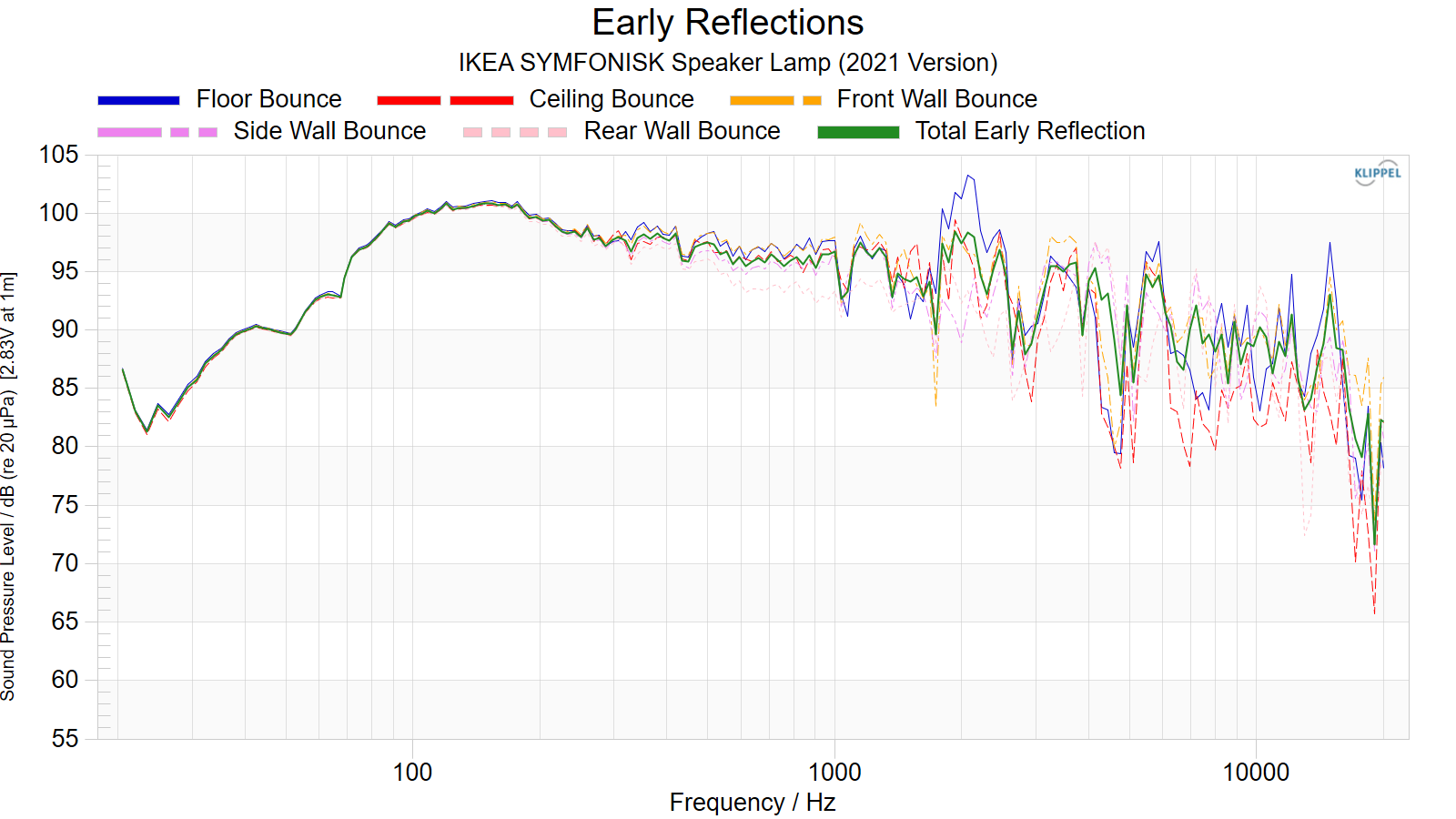
Estimated In-Room Response:
In theory, with complete 360-degree anechoic data on a loudspeaker and sufficient acoustical and geometrical data on the listening room and its layout it would be possible to estimate with good precision what would be measured by an omnidirectional microphone located in the listening area of that room. By making some simplifying assumptions about the listening space, the data set described above permits a usefully accurate preview of how a given loudspeaker might perform in a typical domestic listening room. Obviously, there are no guarantees, because individual rooms can be acoustically aberrant. Sometimes rooms are excessively reflective (“live”) as happens in certain hot, humid climates, with certain styles of interior décor and in under-furnished rooms. Sometimes rooms are excessively “dead” as in other styles of décor and in some custom home theaters where acoustical treatment has been used excessively. This form of post processing is offered only as an estimate of what might happen in a domestic living space with carpet on the floor and a “normal” amount of seating, drapes and cabinetry.
For these limited circumstances it has been found that a usefully accurate Predicted In-Room (PIR) amplitude response, also known as a “room curve” is obtained by a weighted average consisting of 12 % listening window, 44 % early reflections and 44 % sound power. At very high frequencies errors can creep in because of excessive absorption, microphone directivity, and room geometry. These discrepancies are not considered to be of great importance.

Psychoacoustic smoothing (via REW) vs non-smoothed:

Horizontal Contour Plot (not normalized):
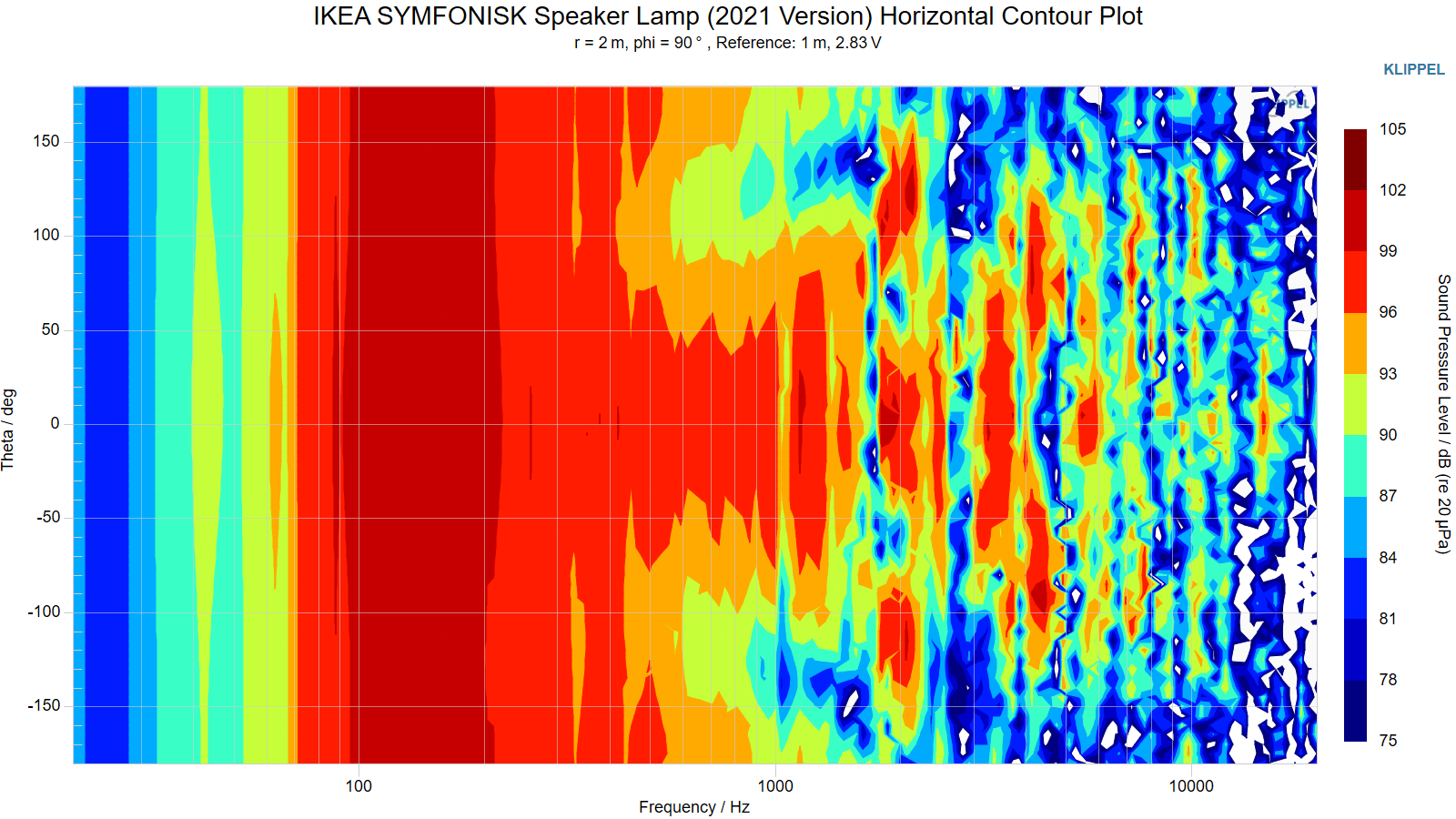
Vertical Contour Plot (not normalized):
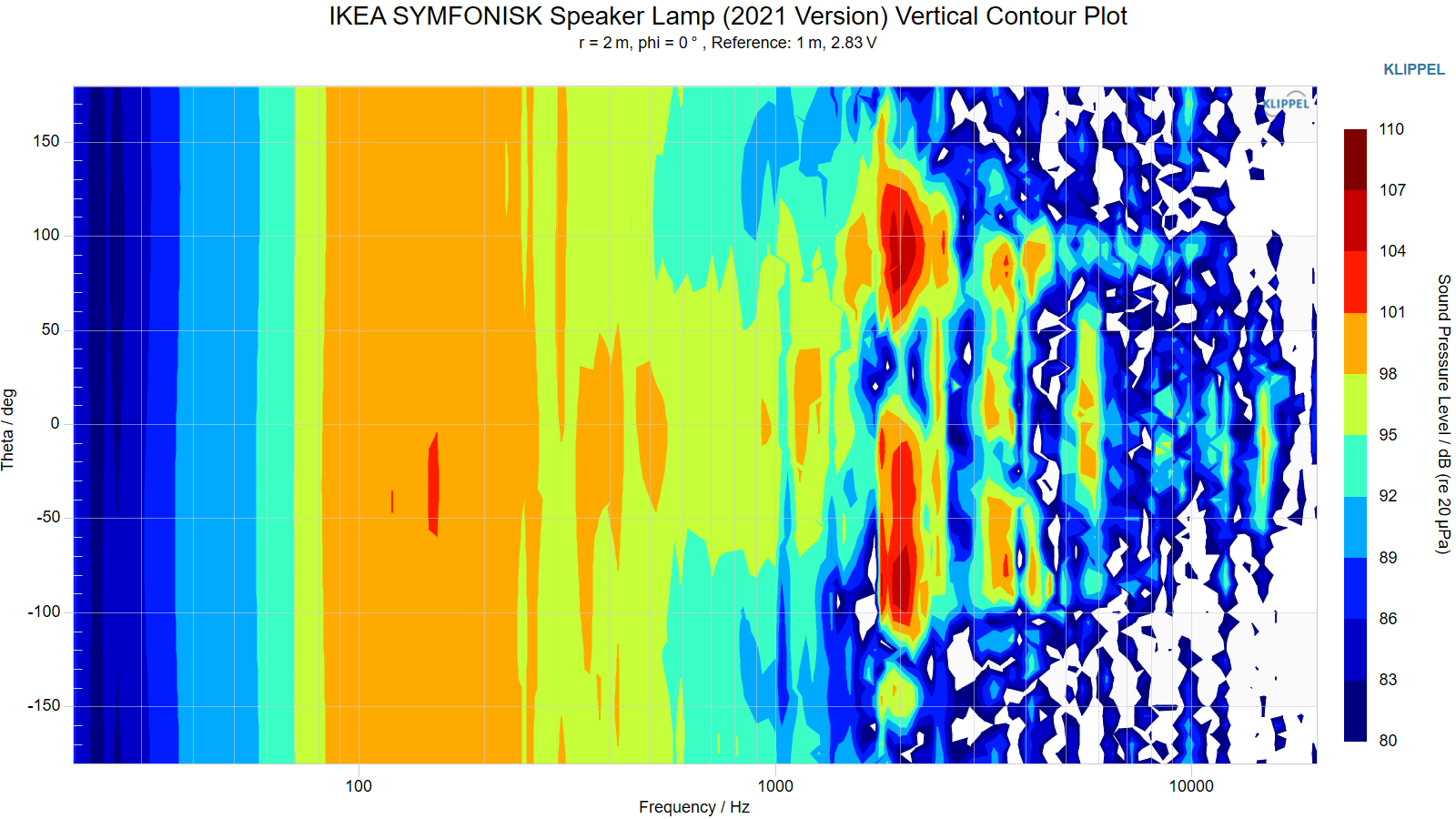
“Globe” Plots
Horizontal Polar (Globe) Plot:
This represents the sound field at 2 meters - above 200Hz - per the legend in the upper left.
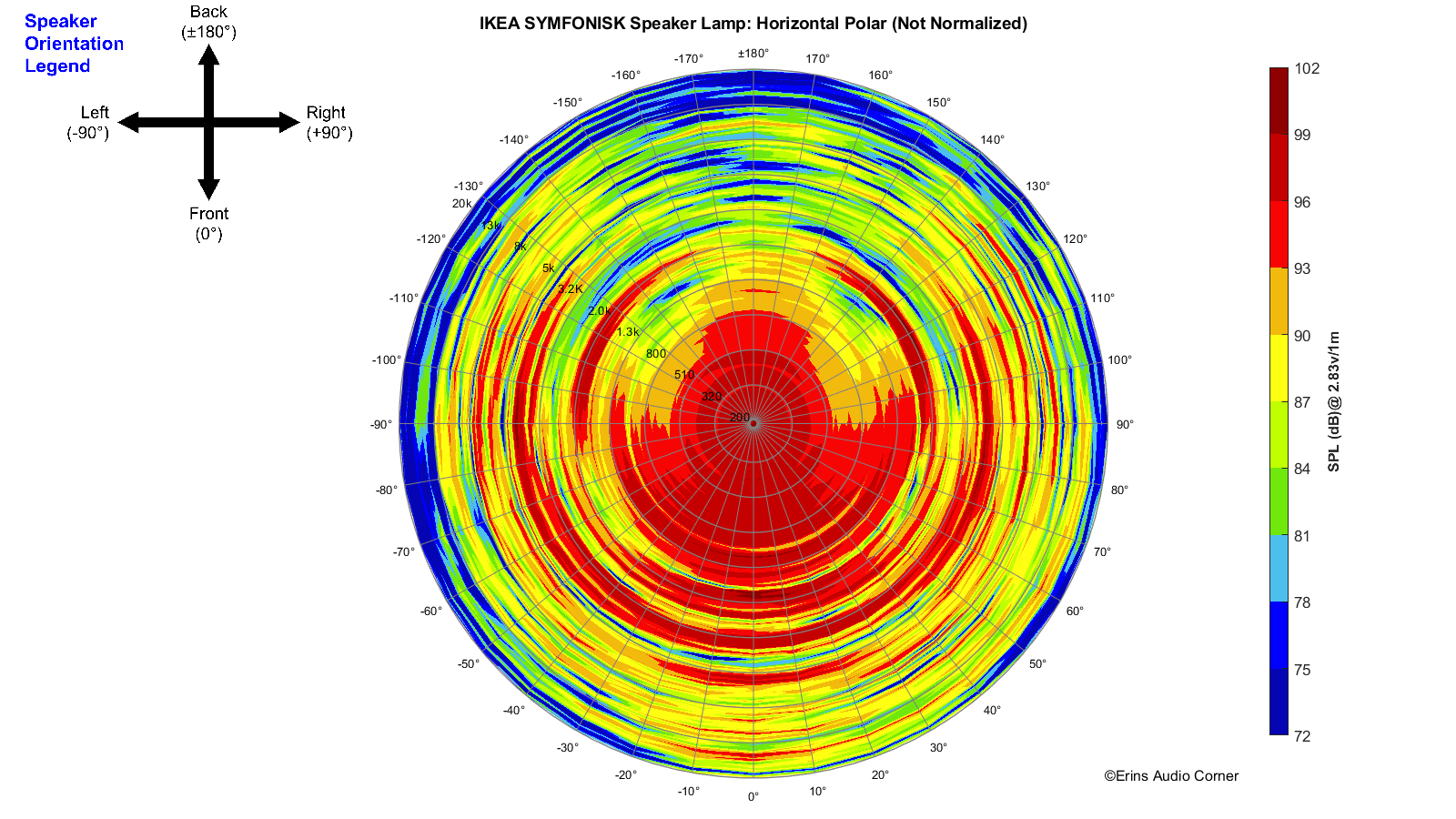
Vertical Polar (Globe) Plot:
This represents the sound field at 2 meters - above 200Hz - per the legend in the upper left.
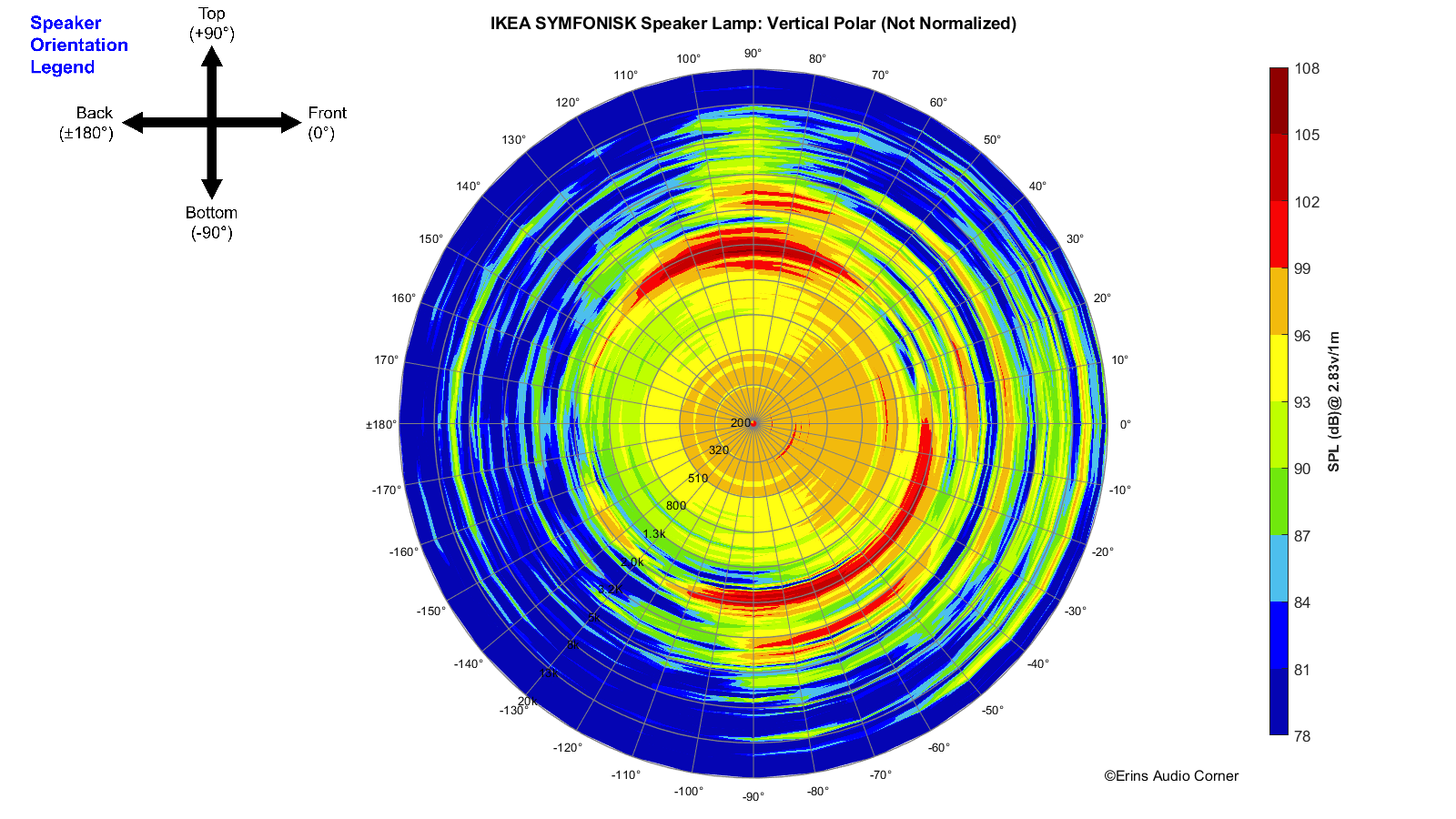
Harmonic Distortion
Harmonic Distortion at 86dB @ 1m:

Parting / Random Thoughts
As stated in the Foreword, this written review is purposely a cliff’s notes version. For details about the performance (objectively and subjectively) please watch the YouTube video.
Look, this thing is a lamp and is also a speaker. We’re not expecting cutting edge HiFi. The CTA-2034 data shows significant high frequency comb filtering but this is the nature of such a product where the speakers are mounted behind a plastic grille with more thought placed on protection and less thought placed on fidelity. However, when you look at the psychoacoustic-smoothed data I provided (done so because it gives us a better idea of the audibility of the comb filtering), you can see it is not as severe as the unsmoothed data looks. While you do still have comb filtering, it’s not end-of-days… and I need to point out again that we are talking about a lamp speaker that isn’t designed to be HiFi per se. So, naturally, we have to cut it some slack. And, yes, the response on-axis is not flat at all. But when you consider the fact this is an omnidirectional speaker, the sloping on-axis response yields a sloped estimated in-room response. And what you do get is a very respectable sound from just about anywhere throughout the room. Especially when your ear is placed at the tweeter height, which I discussed previously.
As for output levels, it does well to fill my large open floorplan living room with sound to satisfy me while I do chores. It has more than enough output for me to listen to music while typing up this very review in my ~1400 ft³ office.
And, as odd as it may be, I actually really liked the push-button switch to turn on/off the light.
If you’re looking for a product that: a) looks pretty nice (many options in style of base and shade as I mentioned previously) b) play music that sounds pretty good c) has decent midbass d) doesn’t have piercing highs
… then this product is for you. It’s a nice piece of furniture to have, works well from SONOS and Apple Airplay (what I used 95% of the time) and frees your living space from one more gadget with its 2-in-1 technology. I’m going to keep it. I dig it. That’s pretty much all there is to it.
Support the Cause
If you find this review helpful and want to help support the cause there are a few ways you can do so below. Your support helps me pay for new items to test, hardware, miscellaneous items needed for testing and costs of the site’s server space and bandwidth. Any help is very much appreciated.
Or using my generic Amazon affiliate link, to purchase items you may need from Amazon.
You can also join my Facebook and YouTube pages if you’d like to follow along with updates.